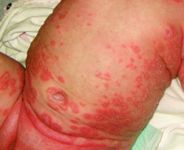Scaly skin eruption in a 6-week-old infant
The mother of a 6-week-old infant is concerned about a generalized, scaly eruption evident over the past 10 days.
• What's the diagnosis?
• How would you treat her?

Clinical findings

Psoriasis

Psoriasis is thought to result from T-cell mediated immune dysregulation, leading to abnormal keratinocytic hyperproliferation.3 Psoriasis is more common in girls with a female-to-male ratio of 2:1. Treatment of psoriasis varies depending on age and extent of disease. First-line therapy for mild disease is topical steroids. Tar, anthralin, salicylic acid, calcipotriol, and UVB phototherapy are alternative options for treatment. Oral retinoids, anti-metabolites, and biologic agents are reserved for older children with more extensive disease. In severe recalcitrant cases, these agents are used in young children.
Differential diagnosis
Seborrheic dermatitis
Seborrheic dermatitis (SD) is a red, scaly eruption that occurs primarily in the sebaceous gland-rich areas of the body such as the scalp, face, post-auricular, and intertriginous areas. It is most commonly seen in infants and adolescents, and the clinical findings often overlap with psoriasis. The cause is not well understood, but hormonal influences on sebum production and the yeast Pityrosporum ovale are possible pathogenetic factors.4
Infantile SD usually appears between the second and 10th weeks of life and peaks at three months of age.5 It usually starts in the scalp or diaper area as red greasy plaques that are covered with yellowish brown crusts. Pruritis is usually mild or absent. The prognosis for infants with SD is excellent, and the condition usually clears with or without treatment in three to four weeks. No treatment is medically necessary, as the condition is self-limited. Treatment is warranted in cases of extensive inflammation or of high parental anxiety.
Application of emollients, mineral oil, or baby oil to the crusts can aid removal with a brush. Shampooing with ketoconazole 2% appears to be safe and efficacious treatment for infants with SD on the scalp.6 Topical steroid use should be limited to cases with severe inflammation, because of risk for systemic absorption.
Recognize & Refer: Hemangiomas in pediatrics
July 17th 2019Contemporary Pediatrics sits down exclusively with Sheila Fallon Friedlander, MD, a professor dermatology and pediatrics, to discuss the one key condition for which she believes community pediatricians should be especially aware-hemangiomas.